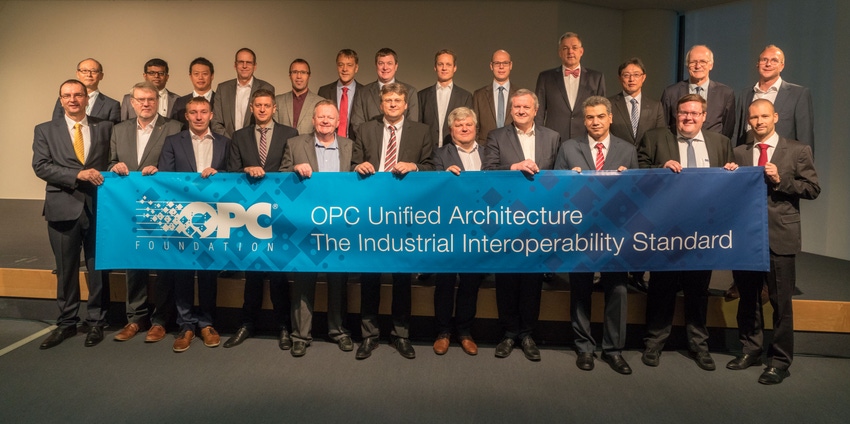Automation Suppliers Back OPC UA
OPC UA TSN looks to leverage gigabit Ethernet bandwidth and Time Sensitive Networking to deliver open networking solutions for smart factories.
January 17, 2019

|
The OPC Foundation’s “OPC UA including TSN down to field level” initiative is being backed by a “Who’s Who” of leading automation and control suppliers. (Image source: OPC Foundation) |
One of the key automation technology megatrends of 2018, OPC UA TSN, took another big step forward with an announcement that the technology is being supported by a wide range of major automation suppliers worldwide, signaling the potential rise of a single, internationally-recognized standard for automation communications. Now, we’re nearing the tipping point, with less talk about the standards itself, and more new product introductions that will no doubt be coming as we head into 2019.
The group of companies backing the technology initiative includes automation and control giants, Rockwell Automation and Siemens, along with a “Who’s Who” of leading suppliers including ABB, Beckhoff, Bosch Rexroth, B&R, Cisco, Hilscher, Hirschmann, Huawei, Intel, Kalycito, KUKA, Mitsubishi Electric, Molex, Omron, Phoenix Contact, Pilz, Schneider Electric, TTTech, Wago, and Yokogawa.
OPC UA and Time Sensitive Networking
It’s hard to remember a technology development in automation and control that has generated the amount of hyperbole surrounding the combination of OPC UA and TSN. Fabrice Jadot, senior vice president and CTO at Schneider Electric is calling the technology itself “a key pillar of the future industrial IoT architectures,” while Stefan Schönegger, vice president of strategy and innovations at B&R claims that “the days of disparate industrial communication protocols are over.”
According to a separate announcement by B&R, OPC UA over TSN will enable plug-and-play networks that are easier to administer and configure. Network stations will communicate “up to 18 times faster than with any protocol available on the market today” and create new possibilities in tightly synchronized motion and control applications.
OPC UA over TSN is also seen as the key to meeting the requirements of future IoT applications. The technology supports networks comprising tens of thousands of nodes and benefits from bandwidth extensions to the Ethernet standard.
CC-Link IE TSN
At the SPS IPC Drives Show in November, the CC-Link Partner Association also announced the completion of the specification for “CC-Link IE TSN” – its next generation network based on the current CC-Link IE technology.
Key features of CC-Link IE TSN include an ability to create flexible IIoT system architectures by adopting TSN Ethernet communication technology as a time sharing method and enabling collection of information from end devices using IP communications while also securing real-time control communication. The goal is to achieve a mixture of high-speed and large-capacity control communication (cyclic data) that can be easily combined with non-control communication (transient data) using network bandwidth of up to 1 Gbps.
|
CC-Link IE TSN has added Time Sensitive Networking (TSN) technology and standards related to IEEE Ethernet to integrate operational technology (OT) and Information technology (IT). (Image source: CC-Link Partner Association) |
CC-Link IE TSN offers four major features, starting with effective integration of control and information communication. The system is designed to provide high priority to cyclic communication used for device control and to allocate bandwidth usage preferentially over information communication needs.
Since it is also compatible with SNMP, it provides superior diagnostic support for network devices. The result is that general purpose SNMP monitoring tools can be used to gather and analyze data from devices compatible with either CC-Link IE TSN or IP communication.
RELATED ARTICLES:
CC-Link IE TSN also implements a time sharing method offering simultaneous time-trigger and bidirectional communications to achieve cycle times of 31.25 μs or less. The CLPA technical group says that adding sensors or increasing the servo axes required for control to expand a production line has minimal effect on overall cycle time.
It also supports both hardware and software platforms, along with both ASIC and FPGA-based hardware. Development of software protocol stacks on a general-purpose Ethernet chip is also envisioned for both master and slave devices.
Al Presher is a contributing editor for Design News, specializing in automation and control and writing on automation topics, machine control, robotics, fluid power, and power transmission since 2002. Previously he worked in the electronic motion control field for 18 years, most recently as VP of Marketing for ORMEC Systems Corp (manufacturer of PC-based servo control systems).
|
About the Author(s)
You May Also Like



.jpg?width=300&auto=webp&quality=80&disable=upscale)


